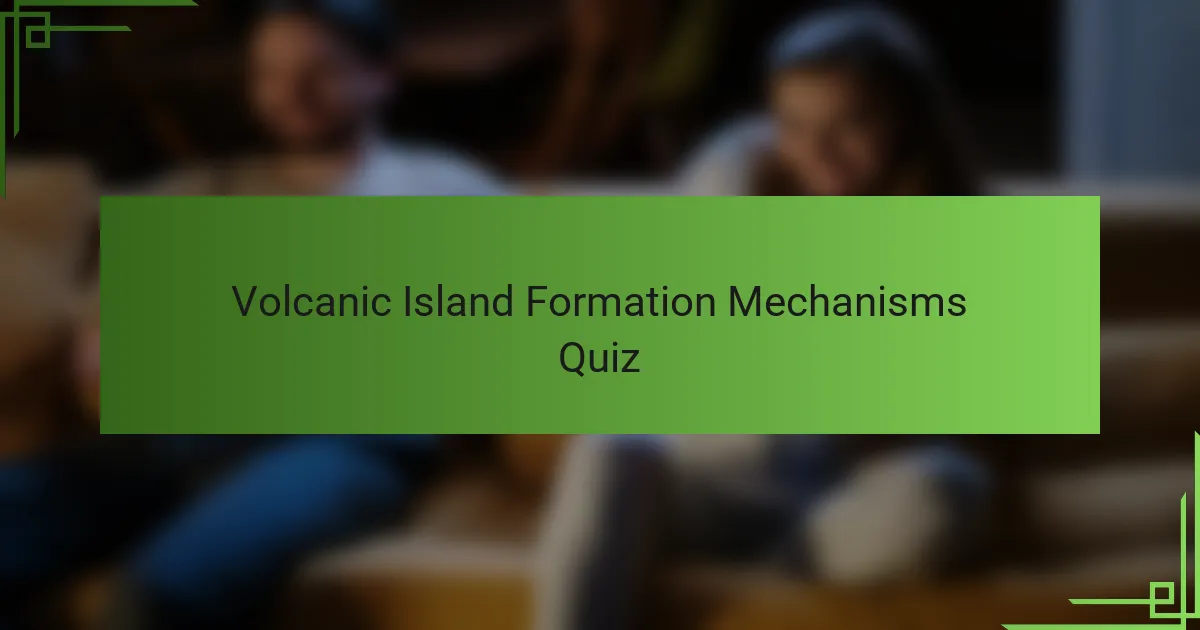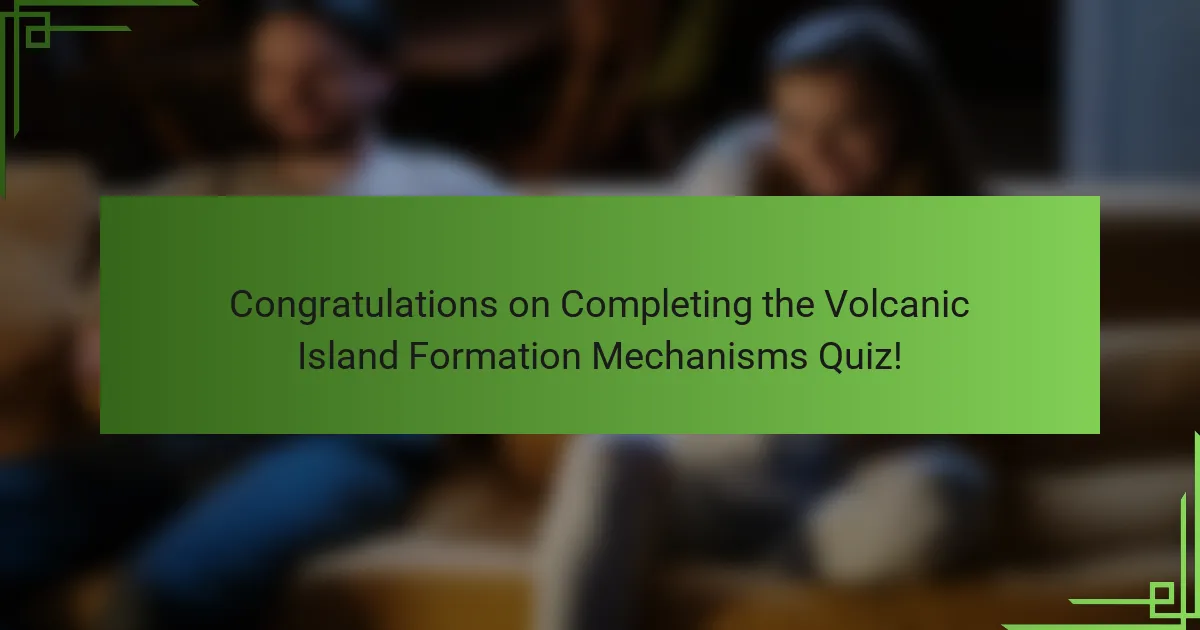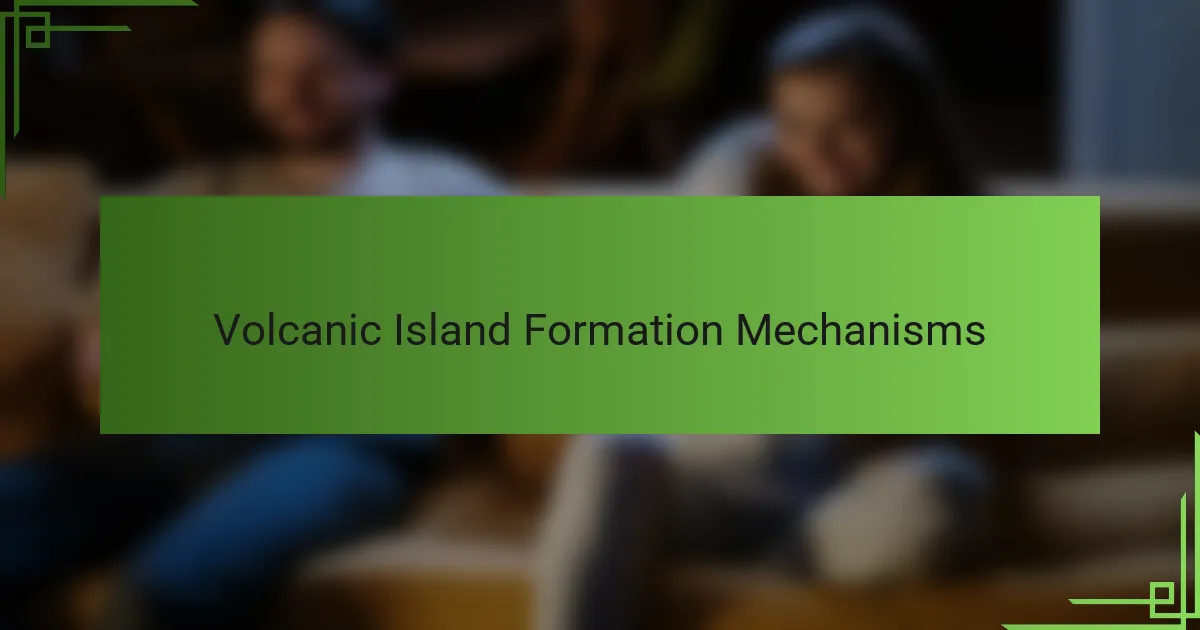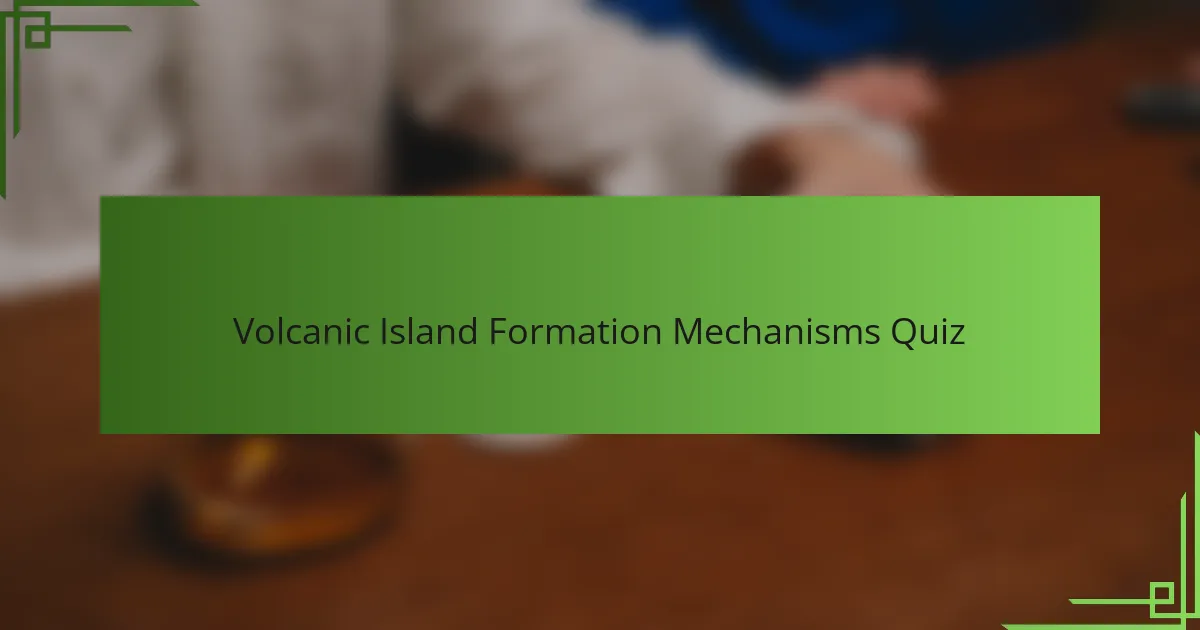
Volcanic Island Formation Mechanisms Quiz
1. What is the primary geological process responsible for the formation of the Hawaiian Islands?
- Hotspot volcanism
- Rift valley extension
- Subduction zone activity
- Plate collision uplift
2. Which volcanic island chain is formed by a hotspot beneath the Pacific Plate?
- Galápagos Islands
- Mariana Islands
- Aleutian Islands
- Hawaiian Islands
3. In which ocean are the volcanic islands of the Galápagos located?
- Atlantic Ocean
- Indian Ocean
- Pacific Ocean
- Southern Ocean
4. What type of volcano commonly forms volcanic islands like Surtsey near Iceland?
- Cinder cone volcano
- Shield volcano
- Caldera volcano
- Stratovolcano
5. Which volcanic island is known for being formed during a volcanic eruption in 1963 off the coast of Italy?
- Isola Ferdinandea
- Pantelleria
- Stromboli
- Vulcano
6. How does seafloor spreading contribute to the formation of volcanic islands like those in the Azores?
- Seafloor spreading causes sediment buildup that eventually rises above sea level to form volcanic islands.
- Seafloor spreading at the Mid-Atlantic Ridge allows magma to rise and form new crust, creating volcanic islands like the Azores.
- Seafloor spreading pushes continental plates together, causing volcanic islands to form through compression.
- Seafloor spreading triggers underwater earthquakes, which uplift existing rock to become volcanic islands.
7. What is the name of the tectonic plate that interacts with the Pacific Plate to create volcanic islands in the Mariana Islands?
- Cocos Plate
- Philippine Plate
- Nazca Plate
- Caribbean Plate
8. Which famous volcanic island is located in the Caribbean and formed by subduction zone volcanism?
- Martinique
- Barbados
- Aruba
- Bermuda
9. Which Indonesian island is volcanic and known for the active volcano Mount Merapi?
- Sulawesi
- Bali
- Java
- Sumatra
10. What volcanic island arc results from the subduction of the Pacific Plate under North America along the Aleutian Islands?
- Aleutian Islands Arc
- Kuril Islands Arc
- Tonga Islands Arc
- Mariana Islands Arc
11. Which island in Japan was formed by the activity of the Izu-Bonin-Mariana volcanic arc?
- Ryukyu Islands
- Kuril Islands
- Ogasawara Islands
- Izu Islands
12. What volcanic island formed as a result of the eruption of the Big Island in the Hawaiian chain?
- Kauaʻi
- Maui
- Lōʻihi Seamount
- Molokaʻi
13. Which island group in the South Atlantic was formed by volcanic activity related to the Mid-Atlantic Ridge?
- Tristan da Cunha
- Ascension Island
- South Georgia Island
- Falkland Islands
14. How do hotspot volcanoes differ in volcanic island formation compared to island arcs like the Tonga Islands?
- Hotspot volcanoes are formed by oceanic crust spreading and divergent plate boundaries, unlike island arcs which arise from mantle plumes.
- Hotspot islands emerge solely from continental crust melting, whereas island arcs develop from volcanic activity in oceanic crust unrelated to plate boundaries.
- Island arcs form from hotspots beneath continental plates, while hotspot volcanoes occur only at mid-ocean ridges between tectonic plates.
- Hotspot volcanoes form islands from mantle plumes fixed in position, creating chains as tectonic plates move over them, whereas island arcs like Tonga form from subduction zone volcanism between converging plates.
15. What volcanic island in the Mediterranean Sea is part of the Aeolian Islands and is known for persistent volcanic activity?
- Vulcano
- Lipari
- Salina
- Stromboli

Congratulations on Completing the Volcanic Island Formation Mechanisms Quiz!
You’ve just finished a focused journey through the fascinating world of volcanic island formation. This quiz offered a clear view of how islands emerge from underwater volcanic activity. You may have strengthened your understanding of tectonic plates, magma movement, and the processes that build new landmasses. Each question helped connect the dots between geology and geography in an engaging way.
While working through the quiz, you likely discovered key concepts like hotspot volcanism, mid-ocean ridges, and volcanic arcs. These are essential to grasp how Earth’s dynamic surface shapes unique landforms. This knowledge is valuable for anyone curious about natural landscapes or eager to deepen their grasp of physical geography. You have built a solid foundation to recognize volcanic islands on the world map and appreciate their origins.
To expand what you’ve learned, we invite you to explore the next section on this page. It dives deeper into volcanic island formation mechanisms with detailed explanations, illustrations, and real-world examples. This will further enhance your geographic knowledge and enrich your appreciation for the forces shaping our planet. Keep exploring and enjoy the world of geography!

Volcanic Island Formation Mechanisms
Overview of Volcanic Island Formation
Volcanic islands form when magma from Earth’s mantle reaches the surface, solidifies, and accumulates above sea level. The process begins at tectonic boundaries or hotspots, where volcanic activity creates new landmasses. Islands like the Hawaiian chain exemplify this mechanism, growing over millions of years as underwater volcanoes repeatedly erupt and deposit lava.
Role of Tectonic Plate Boundaries in Island Formation
Tectonic plate interactions significantly influence volcanic island formation. At divergent boundaries, such as the Mid-Atlantic Ridge, magma rises as plates separate, forming new crust and islands like Iceland. Convergent boundaries, like the Pacific Ring of Fire, drive subduction zones where oceanic plates descend beneath continental plates, causing magma to erupt and create volcanic island arcs such as the Aleutian Islands.
Hotspot Volcanism and Its Impact on Island Chains
Hotspots are stationary mantle plumes that generate magma independently of plate boundaries. As tectonic plates move over these hotspots, volcanic islands form sequentially. The Hawaiian Islands are a prime example, created by the Pacific Plate moving over the Hawaiian hotspot, resulting in a chain of islands of varying ages and sizes reflecting the plate’s movement.
Shield Volcano Formation on Volcanic Islands
Shield volcanoes characterize many volcanic islands due to their broad, gentle slopes created by low-viscosity basaltic lava flows. These volcanoes accumulate thick layers of lava, gradually elevating the island above sea level. Mauna Loa on the Big Island of Hawaii is a classic shield volcano, illustrating how repeated eruptions develop large volcanic islands.
Submarine Volcanism and Island Emergence
Volcanic islands often start as submarine volcanoes. Underwater eruptions build seamounts through successive lava flows. Once volcanic material surpasses sea level, a volcanic island emerges. The Galápagos Islands demonstrate this process, where underwater volcanic activity gradually created islands that now support diverse ecosystems.
What are volcanic island formation mechanisms?
Volcanic island formation mechanisms are geological processes by which islands are created through volcanic activity. This occurs when magma from beneath the Earth’s crust rises and erupts through the ocean floor, depositing lava that cools and solidifies, gradually building an island above sea level. These mechanisms involve the interaction of tectonic plates and mantle plumes, leading to volcanic eruptions that form landmasses, such as the Hawaiian Islands, known to have formed from a hotspot volcanic activity.
How do hotspots contribute to volcanic island formation?
Hotspots are fixed zones of intense heat in the mantle that cause magma to rise and penetrate the Earth’s crust, creating volcanic islands. When a tectonic plate moves over a hotspot, successive eruptions build a chain of islands. The Hawaiian Islands are a classic example where a tectonic plate drifting over a stationary hotspot led to the formation of a volcanic island chain. Geological dating confirms that islands further from the hotspot are older, supporting this mechanism.
Where do volcanic islands typically form on Earth?
Volcanic islands typically form along tectonic plate boundaries or hotspots in the ocean. Common locations include mid-ocean ridges, subduction zones, and intraplate hotspots. The Pacific Ring of Fire is a prime region with numerous volcanic islands forming due to subduction zones, while the Hawaiian Islands formed over a hotspot in the middle of the Pacific Plate. Geological surveys map these regions as zones of active volcanism and island formation.
When do volcanic islands form during volcanic activity?
Volcanic islands form during prolonged volcanic activity when lava accumulates above sea level. Initially, submarine eruptions build underwater volcanic edifices. When eruption and lava flow continue, volcanic material accumulates to rise above the ocean surface, creating a new island. Historical records of volcanic island emergence, such as Surtsey Island near Iceland forming in 1963, confirm this timescale from underwater eruption to island formation within months to years.
Who studies volcanic island formation mechanisms in geography?
Volcanologists and physical geographers primarily study volcanic island formation mechanisms. These scientists analyze volcanic activity, tectonics, and island growth processes using fieldwork, remote sensing, and geological dating techniques. Organizations like the United States Geological Survey (USGS) and the Geological Society of America conduct research to better understand volcanic island formation, improving knowledge of natural hazards and Earth’s geodynamics.
